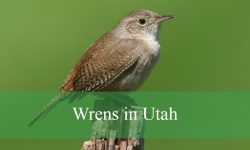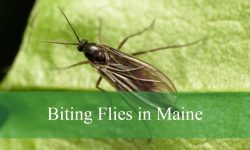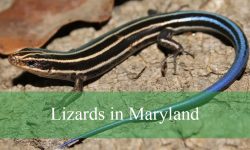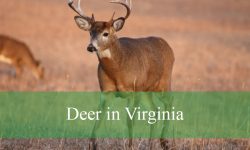Virginia boasts a diverse variety of songbirds that bring vibrant colors and joyful songs to its forests, parks, and backyards. Identifying songbirds in Virginia can enhance your outdoor experience and deepen your appreciation of the state’s rich wildlife. This article highlights 25 common songbirds in Virginia with clear pictures and useful identification tips.
From the vivid Northern Cardinal to the melodic Carolina Wren, these songbirds in Virginia showcase a wide range of plumage, behaviors, and calls. Learning to recognize each species by sight and sound helps bird enthusiasts and beginners alike connect with nature. These birds can be found in many habitats across Virginia, from wooded areas to suburban gardens.
Exploring the world of songbirds in Virginia opens a window into the state’s natural beauty and seasonal rhythms. This guide covers essential details about 25 songbirds in Virginia, including their songs, habits, and preferred environments. Prepare to discover and enjoy the fascinating birds that make Virginia their home all year round.
Common Songbirds Found in Virginia
Carolina Wren
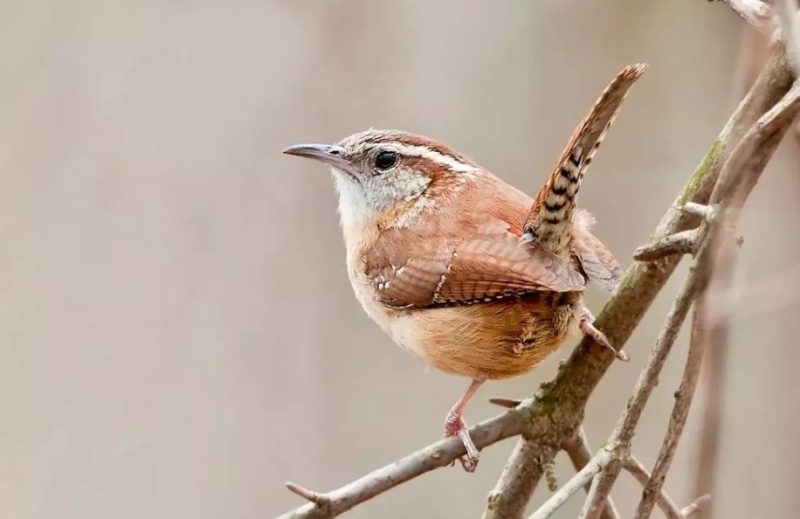
The Carolina Wren is a small, round-bodied bird with a big personality and an even bigger voice. These wrens are covered in warm reddish-brown feathers with a creamy belly and a prominent white eyebrow stripe that makes them easy to identify. Their slightly curved bill is well-suited for probing into crevices for insects.
They typically measure about 4.7 to 5.5 inches long and are highly active, often seen flitting through underbrush or exploring brush piles and woodpiles. Despite their small size, they are fiercely territorial and bold, even challenging their reflections in windows or mirrors.
Carolina Wrens are known for their loud and distinctive “tea-kettle, tea-kettle, tea-kettle” song, which can carry across considerable distances. They are permanent residents in Virginia, thriving in wooded areas, gardens, suburban yards, and thickets. Their adaptability allows them to nest in a variety of nooks, from birdhouses to mailboxes.
Eastern Bluebird
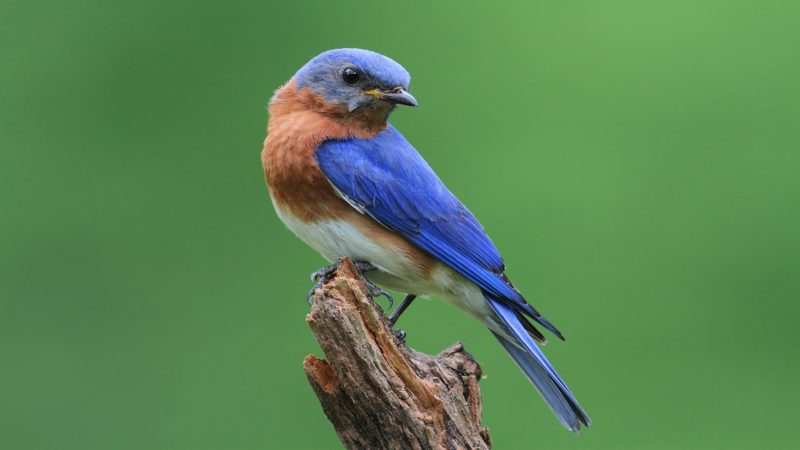
The Eastern Bluebird is a visually stunning bird with bright blue upperparts and a rusty orange throat and chest. Females are more subdued in color but still carry hints of blue and warm tones. Their gentle expressions and delicate features make them a favorite among bird enthusiasts in Virginia.
They are medium-sized songbirds, around 6.5 to 7 inches in length, and are often seen perched on wires or fence posts as they scan for insects. Eastern Bluebirds exhibit a fluttering, buoyant flight and are cavity nesters, frequently using nest boxes set up by humans in open areas.
Their soft, warbling song is a sweet and clear melody that signals the arrival of spring in Virginia. Bluebirds are commonly found in open fields, orchards, meadows, and forest edges. Conservation efforts through the installation of nest boxes have helped their populations rebound throughout the state.
Northern Cardinal
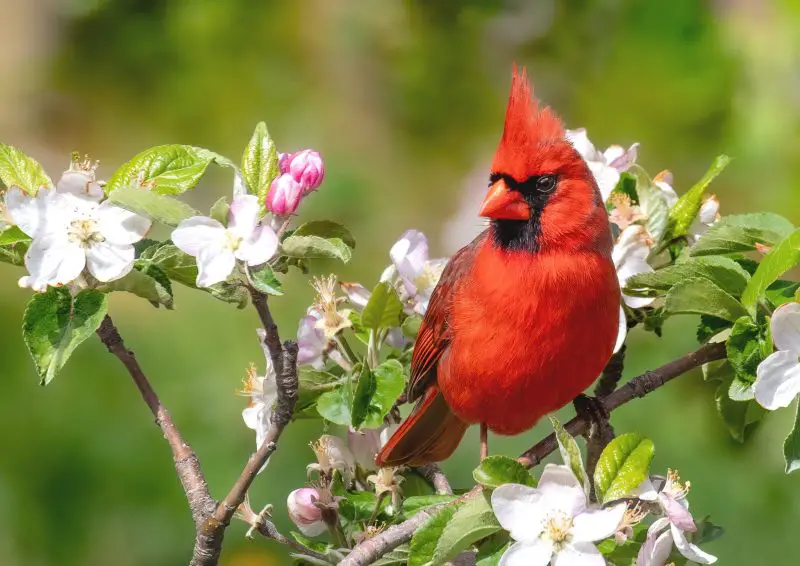
The Northern Cardinal is one of the most iconic and easily recognizable birds in Virginia. Males are a brilliant crimson red with a black mask around the face, while females are a warm brown color with subtle red accents on their wings, tail, and crest. Both sexes have a stout, orange-red beak and a pointed crest that gives them a regal appearance.
These cardinals are medium-sized songbirds, measuring around 8 to 9 inches in length. They are often seen perched on branches, feeders, or fences, and are not shy around people. Their behavior is notably territorial, especially during breeding season, when males will aggressively defend their area from intruders.
Northern Cardinals are known for their rich, melodic whistling songs, which both males and females sing throughout the year. They inhabit a wide range of environments in Virginia, including backyards, woodlands, forest edges, and parks. As the state bird of Virginia, their vivid color and cheerful song make them a favorite among birdwatchers.
American Robin
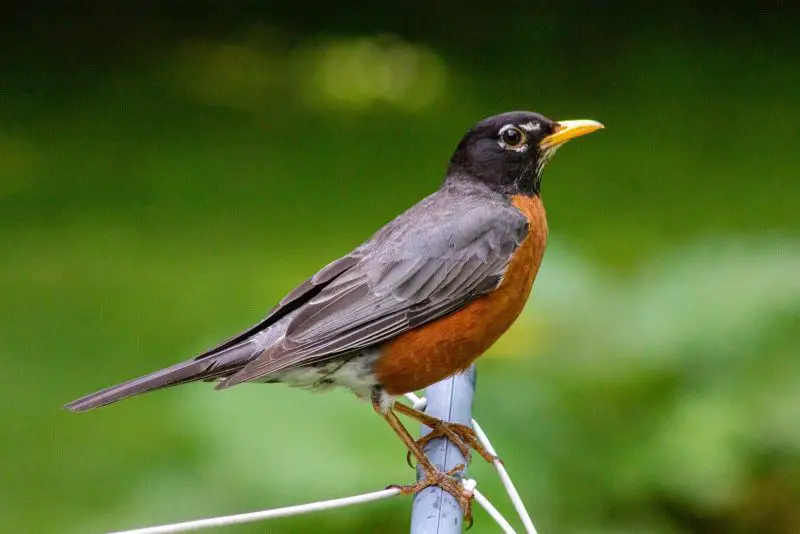
The American Robin is a familiar sight across Virginia, often seen hopping across lawns and grassy areas in search of worms. They have a grayish-brown back, warm orange-red breast, and a rounded body with a white throat and subtle eye ring. Their yellow beak and upright posture add to their distinct appearance.
Measuring about 10 inches in length, robins are among the larger songbirds in the region. They are known for their active foraging behavior, particularly during the early morning hours. These birds are also migratory, though many remain in Virginia during mild winters, especially in wooded areas and suburban landscapes.
Robins are among the first birds to sing at dawn, often delivering a cheerful, flute-like song that signals the start of the day. Their musical notes are repeated in a rhythmic pattern that many people associate with spring. Robins nest in trees, shrubs, and sometimes ledges or structures near homes.
Song Sparrow
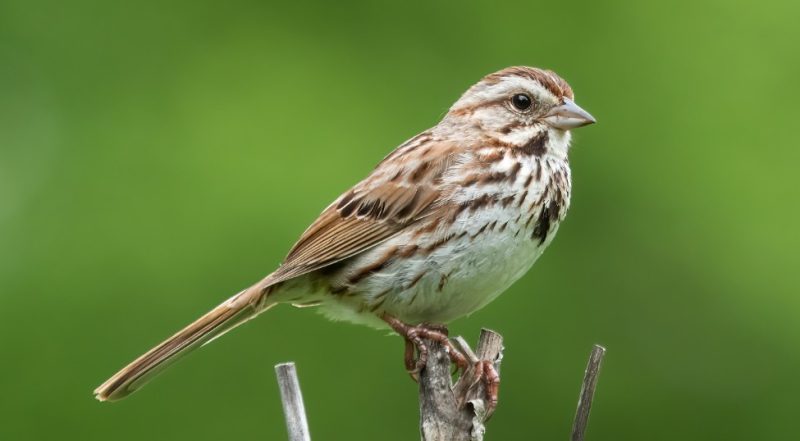
The Song Sparrow is a medium-sized, streaky brown bird with a gray face, a dark line through the eye, and a distinctive central dark spot on its chest. Its plumage helps it blend into shrubs and grasses, making it less conspicuous despite being very common. Their long, rounded tail and rounded head shape are also useful for identification.
These sparrows typically measure about 5 to 6.5 inches long and are ground foragers, often seen flitting out of dense vegetation to peck at seeds or insects. They’re active and agile, hopping between branches or across leaf litter, and are especially noticeable when they pop up to sing from exposed perches.
Song Sparrows are named for their sweet, melodious tunes, which include a mix of trills, buzzes, and repeated notes. Each bird has a slightly different version of its song. They are year-round residents across Virginia and can be found in gardens, marshes, thickets, and forest edges, thriving in a variety of environments.
Tufted Titmouse
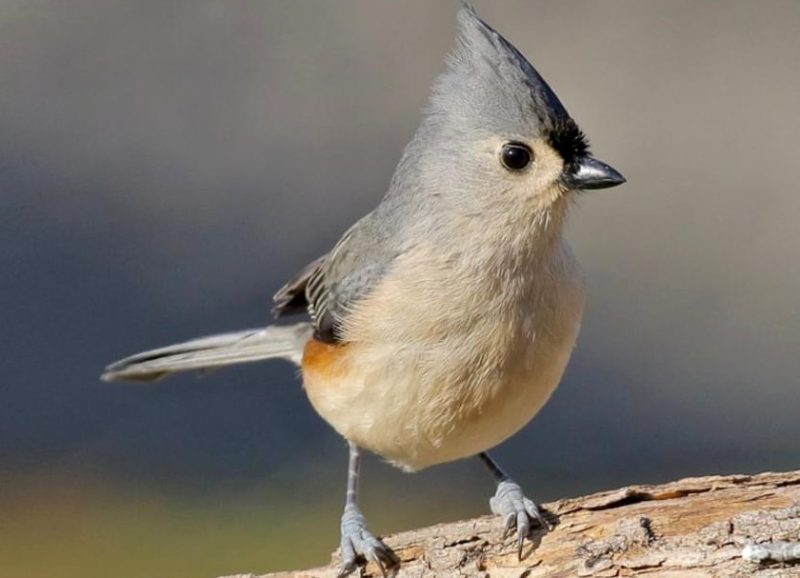
The Tufted Titmouse is a small, active songbird with soft gray plumage, a white belly, and a prominent crest on its head. It has a black patch just above its short, strong bill, giving it a striking facial expression. Its eyes are large and dark, contributing to its alert and curious appearance.
This species measures about 5.5 to 6.3 inches in length and is often seen in mixed flocks with chickadees and nuthatches, especially in winter. Tufted Titmice are frequent visitors to bird feeders, where they grab sunflower seeds and quickly fly off to crack them open. They are agile, quick-moving birds that forage in the tree canopy as well as shrubs.
Their clear, whistled “peter-peter-peter” song is easy to recognize and often echoes through deciduous forests and wooded neighborhoods in Virginia. These birds nest in natural cavities or birdhouses and are year-round residents throughout the state, favoring mature woodlands, parks, and suburban yards.
House Finch
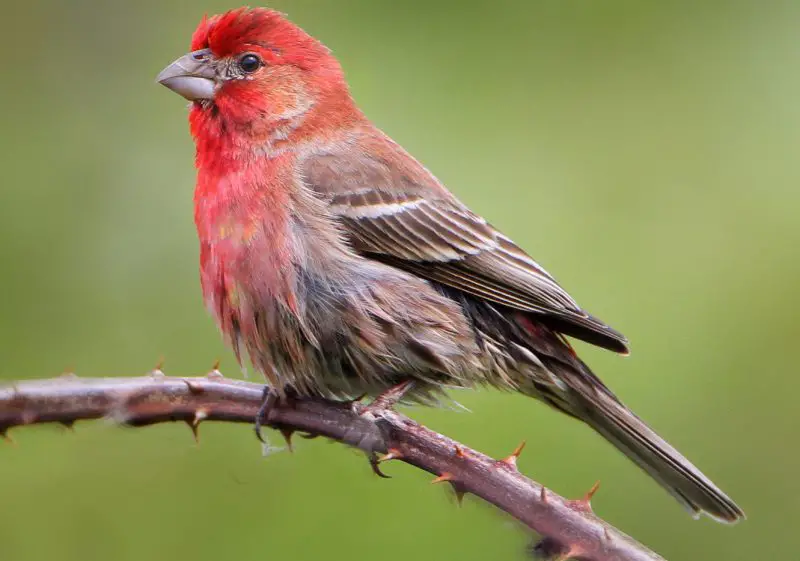
House Finches are small-bodied birds with a cheerful demeanor and pleasant songs. Males are known for their rosy-red coloring on the face, chest, and rump, which contrasts with their streaky brown back and belly. Females lack the red and are covered in brown streaks, making them more subtly marked.
They are typically 5 to 6 inches long and are highly adaptable, thriving in both urban and rural settings. House Finches are common at feeders, where they feed on sunflower seeds and other grains, often in small flocks. They build nests in shrubs, hanging planters, ledges, and other manmade structures.
Their song is a lively, warbling series of notes that rises and falls in pitch, giving them a joyful presence in backyards across Virginia. House Finches are non-migratory and are found year-round throughout the state, especially in suburban areas, open woodlands, farms, and city parks.
Eastern Towhee
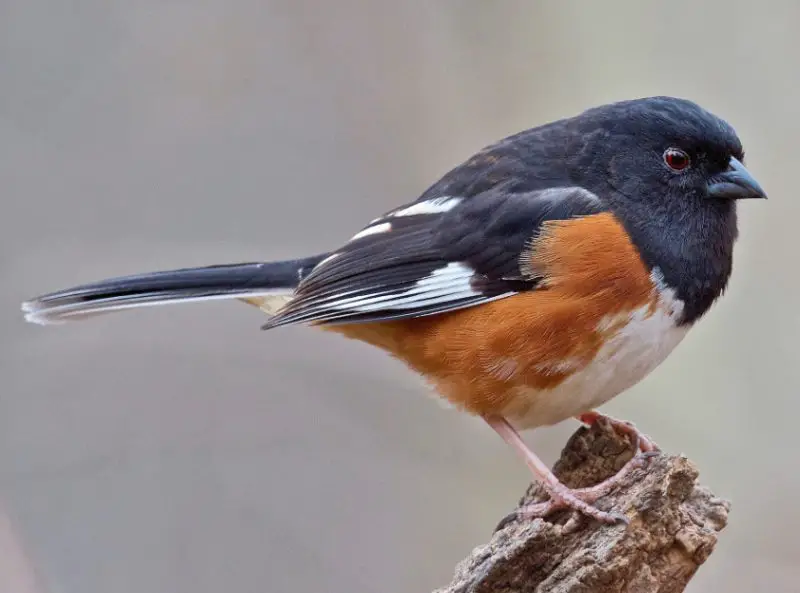
The Eastern Towhee is a striking bird with bold coloring and a rich, musical voice. Males are mostly black above with bright rufous sides and a white belly, while females are similar but have brown instead of black. Their long tails with white corners are often flicked as they move through dense brush.
These birds grow to about 7 to 9 inches long and are primarily ground foragers, using a double-scratch method to uncover insects and seeds in leaf litter. They prefer shrubby edges, overgrown fields, and forest underbrush where they can remain well hidden while feeding and nesting.
The Eastern Towhee’s most famous song is a clear, ringing “drink-your-tea,” which stands out from the quiet rustlings of the underbrush. They also make sharp “chewink” calls. In Virginia, they are mostly resident birds, especially in the warmer parts of the state, and are most vocal during spring and early summer.
Baltimore Oriole

The Baltimore Oriole is a brilliant songbird with eye-catching orange and black plumage that makes it a standout in Virginia’s spring and summer landscapes. Adult males have a solid black head, back, and wings with flaming orange underparts and shoulders, while females and young birds are paler with yellow-orange hues.
Measuring about 6.7 to 7.5 inches long, these orioles are often found flitting through the high branches of deciduous trees, especially in open woodlands and orchards. They feed on nectar, fruit, and insects and are known to visit feeders offering orange slices or sugar water during migration and breeding season.
Their song is a rich, flute-like series of whistles and musical phrases that carry beautifully through the treetops. Baltimore Orioles are migratory and are typically present in Virginia from late April through August. They build intricate hanging nests that resemble woven pouches, usually suspended from slender branches.
Gray Catbird
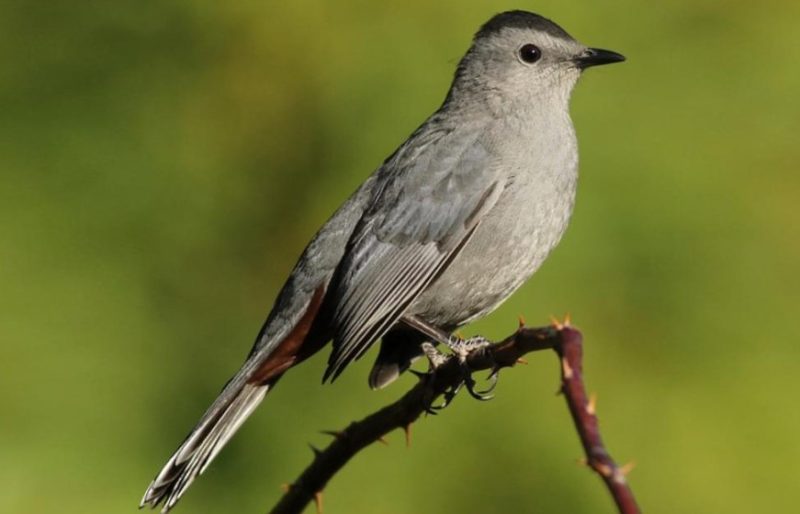
The Gray Catbird is a sleek, medium-sized songbird with uniform slate-gray plumage, a black cap, and a rusty patch beneath the tail. It has a slender black bill and expressive eyes, often giving it an inquisitive appearance. Its long tail and rounded wings make it graceful in flight and agile among dense shrubs.
These birds are about 8.5 to 9.5 inches long and are skilled mimics, able to imitate the songs of other birds, mechanical noises, and even human-made sounds. They are most often seen skulking in thick vegetation, emerging briefly to perch on a branch or feeder before darting back into cover.
Gray Catbirds are named for their cat-like “mew” call, which is part of their broad and complex vocal range. Their songs can last several minutes and are composed of a mix of warbles, chatters, and imitations. They breed in Virginia during the warmer months and prefer habitats such as forest edges, gardens, hedgerows, and wetlands.
Indigo Bunting
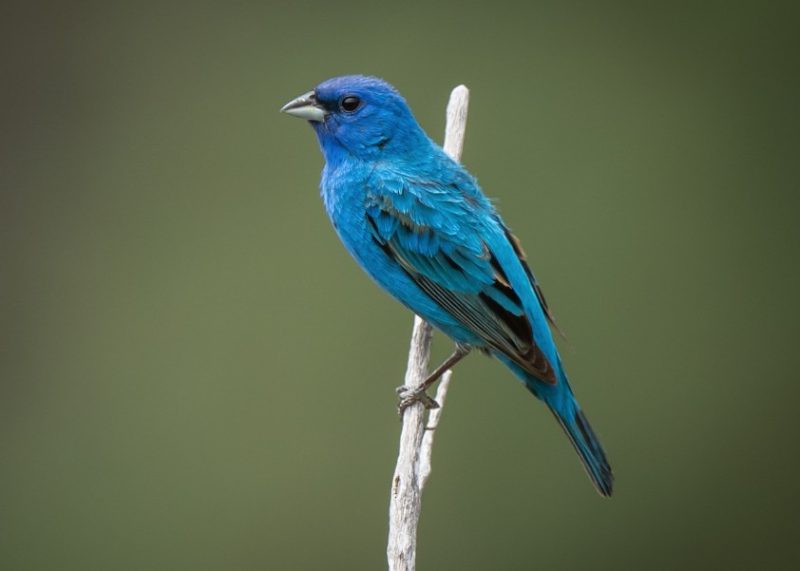
The Indigo Bunting is a dazzling songbird, with adult males showcasing a brilliant, all-over blue plumage that glows in the sunlight. Their color can appear darker or more iridescent depending on lighting conditions. Females and juveniles, in contrast, are a warm brown with faint streaking and a lighter throat, making them harder to identify.
These small birds measure about 4.5 to 5 inches in length and are commonly seen in overgrown fields, woodland edges, and brushy clearings. Males often perch high on treetops, wires, or shrubs to belt out their songs, defending their territories and attracting mates. They are active and fluttery in behavior, frequently hopping among stems and low vegetation.
Indigo Buntings sing a cheerful, high-pitched song made up of paired, repeated notes that sound like “sweet-sweet, chew-chew, sweet-sweet.” Their singing continues from late spring through summer. In Virginia, they are mostly present during the breeding season and migrate south to Central America in fall.
White-throated Sparrow
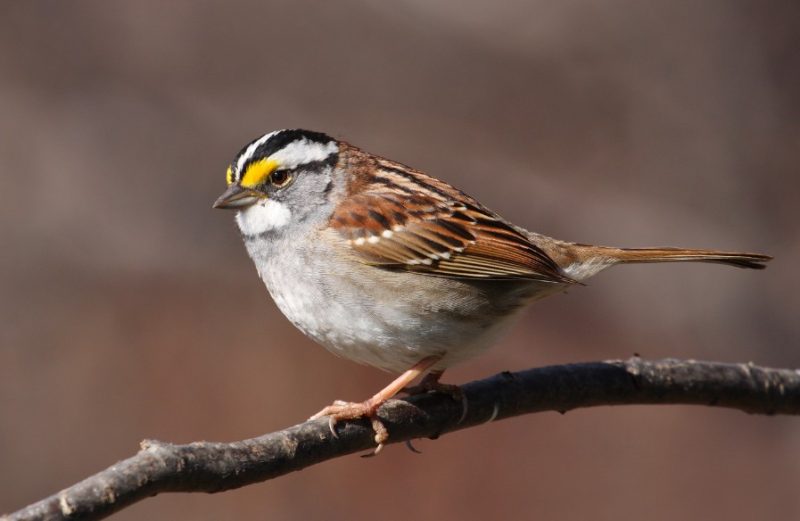
The White-throated Sparrow is a distinctive and melodic bird best known for its crisp white throat and signature yellow patches between the eye and beak. Its plumage is a blend of brown and gray with black-and-white striped crowns, though some individuals show more muted coloring depending on their morph.
This species is around 6.3 to 7.1 inches long and is a regular winter visitor across Virginia. They forage mostly on the ground, scratching through leaf litter in search of seeds and insects. During colder months, they are often seen in flocks at forest edges, backyard feeders, and dense shrubbery near open fields.
Their whistled song is one of the most recognizable in North America, commonly transcribed as “Old-Sam-Peabody-Peabody” or “Oh-sweet-Canada-Canada.” Males sing mostly on their northern breeding grounds, but soft calls can still be heard in Virginia during winter. They begin migrating northward again in early spring.
Chipping Sparrow

The Chipping Sparrow is a small, neat-looking bird with a striking rufous cap, pale gray underparts, and a clean black line through the eye. Its overall appearance is sleek and crisp, making it easy to recognize among other sparrows. The back is streaked with brown and black, helping it blend into grassy or brushy areas when foraging.
These birds measure around 5 inches in length and are active and social, especially in the breeding season when they often appear in pairs or small flocks. Chipping Sparrows are commonly found around lawns, gardens, and open wooded areas, where they forage on the ground for seeds and insects. They also nest in ornamental shrubs and small trees, making them a familiar presence in suburban neighborhoods.
Their song is a rapid, dry trill—often described as “tril-tril-tril”—resembling the sound of a sewing machine or rapid tapping. This repetitive tune is typically sung from a low perch during spring and early summer. In Virginia, Chipping Sparrows are widespread and common during the warmer months, migrating south for the winter.
Purple Finch
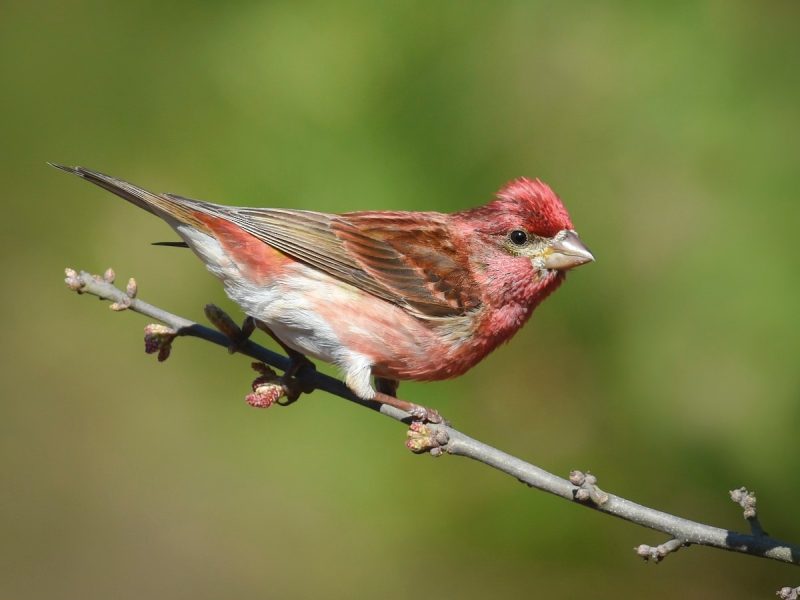
The Purple Finch is a beautifully colored bird with a richer and more raspberry-red tone than the more familiar House Finch. Adult males are covered in deep wine-red hues that extend from the crown to the chest and back, blending into a streaky, lighter belly. Females lack the red and are instead brown and white with bold facial markings and crisp streaks.
They measure about 5 to 6 inches long and prefer coniferous and mixed woodlands, but are also seen at feeders, especially in fall and winter. Purple Finches are somewhat nomadic and irruptive, meaning their numbers can vary widely from year to year in Virginia depending on food supply further north. They feed primarily on seeds, buds, and berries.
Their song is a rich, warbling melody, filled with sweet, rolling notes that rise and fall in tone. It is more musical and fluid than the song of the House Finch. Purple Finches may visit backyard feeders offering sunflower seeds, especially in forested suburbs and rural areas during migration or winter months.
Wood Thrush
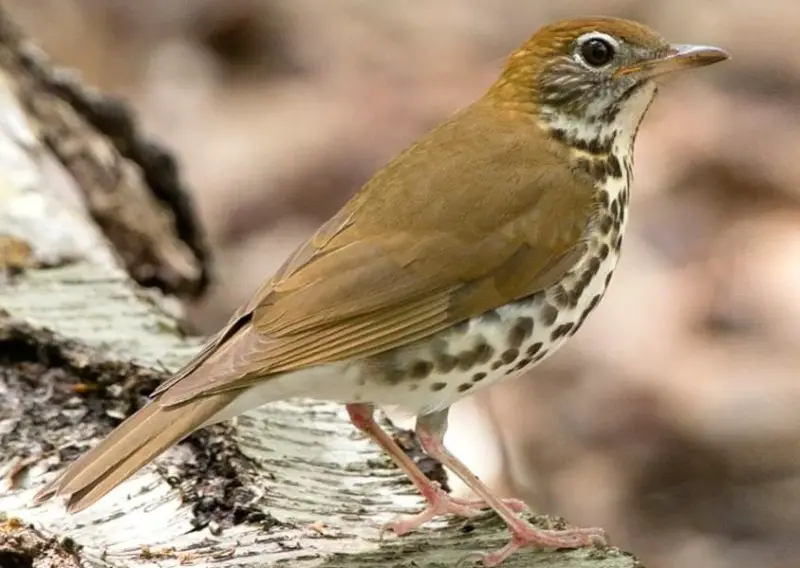
The Wood Thrush is a forest-dwelling songbird renowned for its hauntingly beautiful voice, often heard echoing through the deciduous woodlands of Virginia. It has a warm reddish-brown back and crown, along with a white breast heavily marked with bold black spots that give it a speckled appearance.
This thrush is medium-sized, about 7.5 to 8.3 inches long, and prefers dense understory in mature forests. It forages on the forest floor, flipping leaves in search of insects, snails, and fruit. Although often shy and hard to spot, its presence is unmistakable once it starts singing.
The Wood Thrush’s song is a flute-like series of phrases, each composed of multiple, harmonic notes that sound ethereal and bell-like. Many consider it one of the most beautiful and complex bird songs in eastern North America. Wood Thrushes are present in Virginia during spring and summer and migrate to Central America for the winter.
Northern Mockingbird
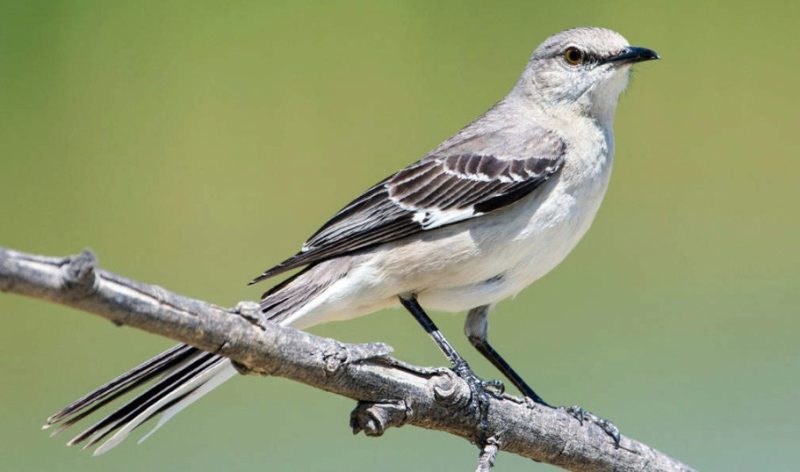
The Northern Mockingbird is a light gray bird with a pale belly and bold white patches on the wings and tail that flash brightly in flight. It has a long tail, slender black legs, and a slightly curved bill. Though visually subtle, it makes up for it with its bold personality and constant vocalizations.
Measuring about 9 to 10 inches in length, the mockingbird is commonly seen perched high on fences, utility lines, or treetops, especially in suburban and urban environments. It fiercely defends its territory and can be seen chasing away intruders, including cats, hawks, and even humans.
Its greatest talent lies in its song—an ever-changing performance made up of imitations of other birds, frogs, and even mechanical noises. Mockingbirds sing throughout the day and often well into the night, especially during spring. In Virginia, they are year-round residents and thrive in backyards, gardens, parks, and open areas with scattered shrubs and trees.
Brown Thrasher
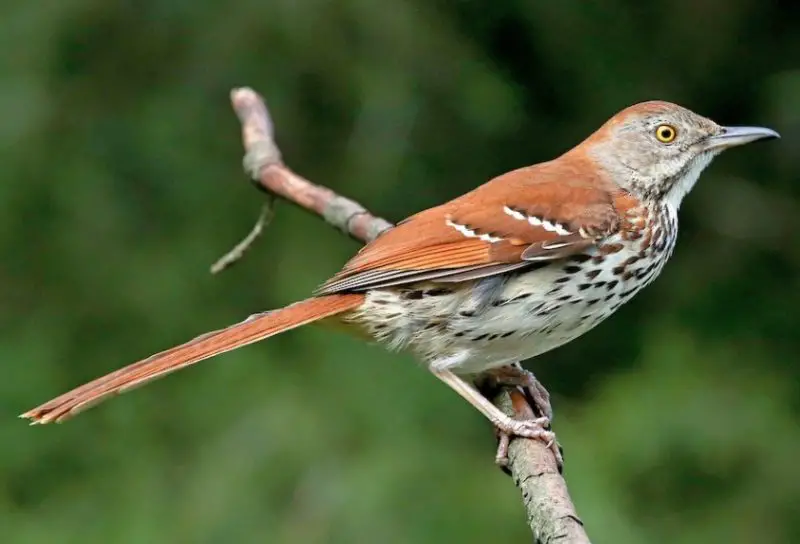
The Brown Thrasher is a striking, long-tailed bird with rich reddish-brown upperparts and heavily streaked underparts. Its eyes are a vivid yellow, and it has a slightly curved bill suited for digging through leaf litter. With its long tail and slender body, it resembles its cousin, the Northern Mockingbird, but is more secretive in behavior.
This bird measures about 9 to 11 inches in length and prefers dense shrubs, thickets, and hedgerows where it can stay partially hidden. It forages mostly on the ground, flipping leaves in search of insects, seeds, and berries. Though often elusive, it may perch in open areas during the breeding season to sing loudly.
Brown Thrashers are among the most accomplished songbirds in North America, capable of performing over 1,000 different song phrases. Their vocalizations are made up of sharp, musical couplets and mimicry, repeated only once or twice. In Virginia, they are found in forest edges, suburban shrubbery, and rural fields with thick underbrush.
Blue-gray Gnatcatcher
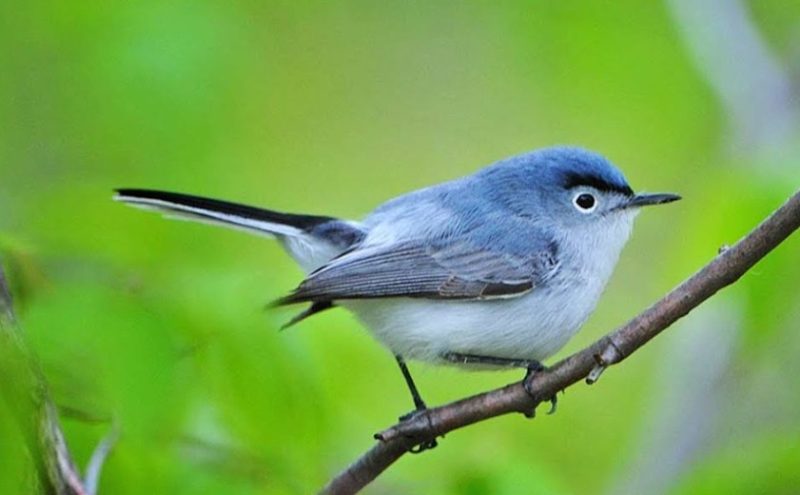
The Blue-gray Gnatcatcher is a tiny, energetic bird with soft blue-gray plumage, a white eye ring, and a long black-and-white tail that it flicks constantly. Its small size and nervous movements make it seem almost restless as it darts through foliage. The bird’s thin bill is perfect for catching small insects mid-air or off leaves.
They measure around 4 to 5 inches in length and are most commonly found in open woodlands, along streams, or in forest edges with shrubby growth. These gnatcatchers are agile and curious, often hovering briefly or making short flights to grab gnats and other flying insects. Their constant tail flicking helps flush out prey from vegetation.
Their vocalizations consist of high-pitched, wheezy “tszee” or “chit-chit” calls that are often difficult to hear unless you’re nearby. During spring and summer, they also sing soft, jumbled songs made up of whispers and sharp notes. In Virginia, Blue-gray Gnatcatchers are warm-season residents and can be seen from April through September.
Common Yellowthroat

The Common Yellowthroat is a small, vibrant warbler with olive-brown upperparts and a bright yellow throat and chest. Males are easily recognized by their black facial mask bordered above by a white or gray line, while females lack the mask and are duller overall. Their compact bodies and rounded wings help them navigate dense vegetation with ease.
They are about 4.5 to 5.1 inches long and spend much of their time skulking in thick shrubs and wetland edges. These birds prefer moist habitats like marshes, overgrown fields, and brushy streambanks where they hunt for insects close to the ground. Despite their secretive habits, they are often heard before they are seen.
The song of the Common Yellowthroat is a repetitive, cheerful “witchety-witchety-witchety,” which carries well through the brush. Males frequently sing from exposed perches during the breeding season. In Virginia, they are common throughout the warmer months, especially in lowland areas with dense cover.
Yellow Warbler

The Yellow Warbler is a glowing lemon-yellow bird with subtle reddish streaks across its chest and a plain, rounded head. Males are especially vivid, while females are slightly paler but still bright overall. Their dark, beady eyes stand out against the plain face, giving them a soft and cheerful appearance.
These warblers are about 4.7 to 5.1 inches in length and are highly active, often flitting through willows, alders, and wet thickets in search of caterpillars and insects. They are commonly found near streams, ponds, and wet forests where they build well-hidden, cup-shaped nests among dense foliage.
Their song is a high-pitched, cheerful “sweet-sweet-sweet, I’m-so-sweet” that rises and ends quickly. It’s one of the most recognizable warbler songs in spring. In Virginia, Yellow Warblers are summer breeders and can be seen from April through August in moist woodland edges and riparian habitats.
Pine Warbler
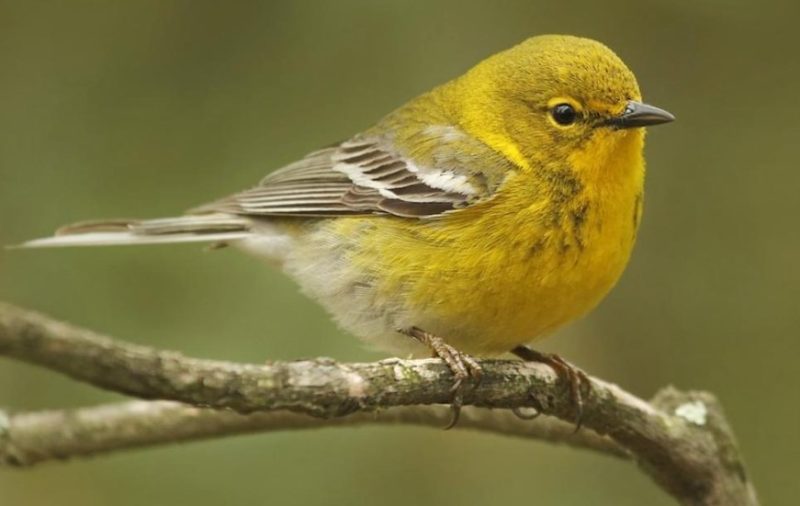
The Pine Warbler is a soft yellow songbird with olive-green tones on its back, white wing bars, and a pale belly. Males are brighter yellow than females, while juveniles appear more muted. Unlike many other warblers, this species has a relatively stocky build and a sturdy, straight bill.
Measuring about 5.1 to 5.5 inches in length, Pine Warblers are often found high in the canopies of pine-dominated forests, making them more often heard than seen. They are one of the few warblers that eat seeds in addition to insects and will readily visit feeders, especially those offering suet or sunflower seeds.
Their song is a slow, musical trill—somewhat similar to the Chipping Sparrow’s but more melodic and less mechanical. This gentle trill is often the first warbler song heard in early spring. In Virginia, Pine Warblers are common in pine forests and mixed woodlands, and many individuals remain year-round, particularly in the southeastern part of the state.
Black-and-white Warbler
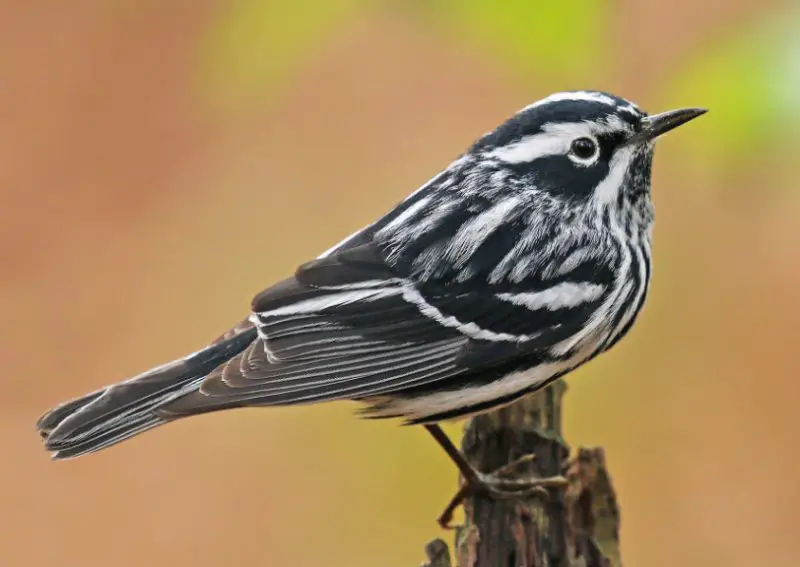
The Black-and-white Warbler is a distinctive bird with bold black-and-white stripes running lengthwise across its body, resembling a tiny zebra. Males have darker markings, including a black cheek patch, while females are paler but still patterned. Its body shape is slim and agile, well suited for clinging to bark.
These birds measure about 4.3 to 5.1 inches long and have a unique foraging behavior: instead of flitting through leaves like many warblers, they creep along tree trunks and branches like a nuthatch or woodpecker. They feed on insects hidden in bark crevices and are often seen spiraling around tree limbs in mature forests.
Their song is a high-pitched, squeaky “wee-see, wee-see, wee-see,” often described as sounding like a squeaky wheel or a quick alarm bell. In Virginia, Black-and-white Warblers are summer breeders in deciduous or mixed woodlands and can be found during migration in various forested habitats across the state.
FAQ about Songbirds in Virginia
What are some common songbirds found in Virginia?
Some of the most common songbirds in Virginia include the Northern Cardinal, American Robin, Carolina Wren, Eastern Bluebird, Song Sparrow, and Tufted Titmouse. These species are seen year-round in a variety of habitats, from forests to suburban backyards. During migration seasons, additional species like warblers and orioles are also frequently observed.
When is the best time to observe songbirds in Virginia?
Spring and early summer are ideal times for observing songbirds in Virginia. This is when most birds are singing to establish territories and attract mates. Migration periods in spring (April–May) and fall (September–October) also bring many species through the state, offering excellent birdwatching opportunities.
Do all songbirds in Virginia stay year-round?
No, not all songbirds stay in Virginia year-round. Some, like the Northern Cardinal and Carolina Wren, are permanent residents. Others, such as the Yellow Warbler and Baltimore Oriole, migrate to warmer regions in fall and return in spring. Winter visitors include species like the White-throated Sparrow and Dark-eyed Junco.
What should I feed songbirds in my Virginia backyard?
Common food offerings for Virginia songbirds include black oil sunflower seeds, suet, peanuts, nyjer (thistle) seed, and mealworms. Different species prefer different foods: finches like nyjer, woodpeckers enjoy suet, and bluebirds favor mealworms. Providing clean water and native plants also helps attract more birds.
Where can I go birdwatching in Virginia?
Virginia offers many excellent locations for birdwatching. Some top spots include Shenandoah National Park, Great Dismal Swamp National Wildlife Refuge, Huntley Meadows Park, and the Eastern Shore of Virginia National Wildlife Refuge. Local parks, greenways, and even well-planted backyards can also attract a wide variety of songbirds.
How can I identify songbirds by their song?
Learning bird songs takes time, but many species have distinctive calls. For example, the Eastern Towhee says “drink-your-tea,” and the Carolina Wren repeats a loud “tea-kettle, tea-kettle.” Apps like Merlin Bird ID or field guides with audio features can help you learn to recognize calls by ear.
Are songbirds protected in Virginia?
Yes, most songbirds in Virginia are protected under the Migratory Bird Treaty Act, which makes it illegal to harm, capture, or disturb native bird species or their nests without a permit. It’s important to provide safe habitats and avoid disturbing nesting areas, especially during breeding season.


